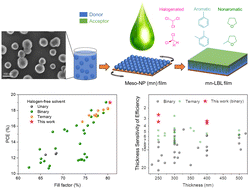Water-based layer-by-layer processing enables 19% efficient binary organic solar cells with minimized thickness sensitivity†
Abstract
Water processing is an ideal strategy for the eco-friendly fabrication of organic solar cells (OSCs), exhibiting a strong market-driven need. Herein, we developed a sequential layer-by-layer (LBL) processing for OSCs using a water-based nanoparticle (NP) ink containing a donor to construct a mesostructured NP layer for infiltration with an acceptor. The NP synthesis and deposition process induced a mesostructured NP (mn)-layer with high molecular packing. The subsequent thermal treatment coalesced the mn-layer and resulted in an optimized vertical phase separation. Due to the efficient carrier transport, binary PM6:BTP-eC9 solar cells fabricated by the water-borne mn-LBL technique achieved an efficiency exceeding 19.0% with long-term stability and accessible upscaling property, which were superior to their counterparts obtained from halogenated solvent processing. Additionally, after fine-tuning the vertical morphology through the mn-LBL strategy, the efficiencies of the thickened device (18.2% for 250 nm and 17.2% for 400 nm) surpassed all the reported binary OSCs with high thicknesses. Furthermore, the tunable mesoporosity allowed solvent- and material-independent processing to be achieved regardless of the acceptor solution's infiltrability into the donor film. This elegant approach showcases the potential of molecularly designing “green” solvent-compatible acceptors in conjunction with the mn-LBL strategy to enable the effective lab-to-fab translation of OSCs.



 Please wait while we load your content...
Please wait while we load your content...